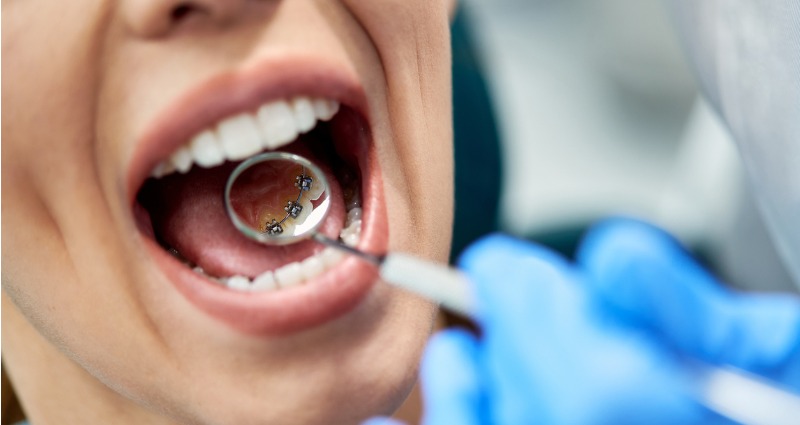Lingual braces have become increasingly popular in recent years. Their rise in popularity is related to several different factors, including more adults seeking orthodontic treatment and more people being self-conscious of their looks. Lingual braces can treat most cosmetic dental issues, except for severe cases. A patient with an overbite will generally achieve a similar outcome, whether they choose lingual or standard braces.
What is an Overbite?
An overbite is when the upper front teeth overlap too far with the bottom teeth. An overbite occurs when the lower jaw is underdeveloped or there is an inconsistency with the size of the front teeth. Overbites are one of the main reasons people invest in braces. By fixing an overbite with braces, there is less chance of damaged front teeth, and gum damage which can occur in the long-term.
What Are Lingual Braces?
Lingual braces are fitted to the inside of teeth rather than the outside of teeth. Known as ‘inside braces’, they have a custom bracket attached to the back of each tooth which helps to conceal them. Lingual braces can apply pressure to certain teeth to move them into their desired position while not being visible on the front of the teeth like standard braces. Lingual braces are ideal for people who are self-conscious about their appearance and are a popular choice amongst adults.
Can Lingual Braces Fix an Overbite?
Most patients with an overbite have the option of lingual braces, however, it’s always best to have an appointment with an orthodontist before deciding which orthodontic treatment method you’ll choose. Patients with a very deep overbite may experience lingual brackets coming off their teeth more often than other patients. An orthodontist can advise you on the pros and cons based on your individual case.
Pros of Choosing Lingual Braces
Unless otherwise advised by an orthodontist, many patients may opt for lingual braces purely based on aesthetics and/or personal preference. There are some great benefits to settling on lingual braces as your method of treatment, including:
Lingual Braces Are Not Visible
The aesthetics of lingual braces is by far the biggest benefit. With lingual braces, most people won’t know you even have them. A person needs to sit or stand close to be able to see the brackets on the inside of their teeth. People who are conscious about their appearance may feel more confident with lingual braces as opposed to the standard buccal braces. Some people choose lingual braces rather than opting out of orthodontic treatment because they have a special event coming up, such as a school formal or wedding.
Clear and ceramic braces, as well as Invisalign, are other aesthetically inconspicuous options for orthodontic treatment. However, they are still visible because they are applied to the outside of teeth. Lingual braces are the only option for patients who want a near-invisible option.
Protecting the Mouth
Standard braces can cause scratches and ulcers to the inside of a patient’s cheeks and lips, particularly during the early stage of treatment as the mouth gets used to the brackets and wires. Waxing your braces can help smooth out rough brackets or wire, but it’s quite common for patients to experience some discomfort. With lingual braces, the teeth protect the inside of the cheeks and lips from the braces, so there is little concern regarding cheeks and lips however the tongue may sometimes be irritated.
Cons of Choosing Lingual Braces
While there are some fantastic benefits to choosing lingual braces as your method of treatment, there are a few cons that you’ll need to consider before making a decision.
Adjusting Your Speech
Lingual braces take some getting used to with speech. Having braces applied to the back of the teeth means the tongue can’t sit in its usual place when forming sounds. This can result in patients speaking with a lisp, though for most people with lingual braces, the lisp doesn’t last long before your speech returns to normal. Some people can reduce the severity and length of a lisp by spending time practicing their speech and difficult words in the early weeks after their braces are applied.
Cost
Lingual braces are the most expensive orthodontic treatment option. The brackets are custom-made with 3D imaging and designed to the shape of the tooth, unlike buccal braces which have a standard bracket. Custom brackets are more comfortable and reduce the chance of brackets popping off and requiring an emergency repair.
Fitting lingual braces requires an orthodontist who is highly experienced in lingual braces to ensure the brackets are aligned with the contours of the back of teeth. Most orthodontists will see their lingual braces patients more often than patients with standard patients to check on the progress, and to make sure there are no issues with cleaning around the brackets and wires on the backs of teeth.
Treatment Time
Lingual braces can have a longer treatment time than standard braces, but it depends on the individual. For some patients, treatment time is the same no matter which orthodontic option they choose. Your orthodontist will be able to give you an estimate during the first appointment.
Discuss Your Orthodontic Options
The beauty of orthodontics is that there are multiple options available to most patients that will provide the same desired outcome.
Ready to discuss your options? Find an orthodontist near you!
Source: https://www.theorthodontists.com.au/blog/can-you-fix-an-overbite-with-lingual-braces

